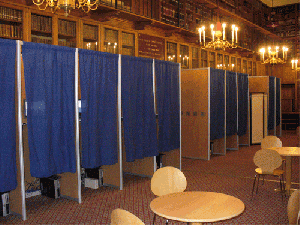
Voting booths
(Image by (From Wikimedia) Electiontechnology at Eng, Author: Electiontechnology at Eng) Details Source DMCA
It's not news to anyone that American elections have become long, costly, complicated, time-consuming affairs. Each campaign begins the day after the previous election, swamping news cycles and distorting public dialog for two to four years.
Of all the activities involved in the ongoing drama of politics, one should be quite simple: The final, affirmative act of casting a vote. Instead, voting has become more and more difficult, more and more complicated, and more and more subject to counting error over the years.
Sarah Breitenbach of the Pew Charitable Trust's Stateline project reports on a developing backlash against the problems of fragile high-tech voting systems. After Florida's "hanging chad" debacle in 2000, most states and cities moved to new, theoretically easier to use, but technologically more complex, voting machines. Those machines came with their own problems, including very real fears that election results could be (and perhaps were) hacked and manipulated.
More than a decade later, after years of acrimonious debate, close elections turning on questionable vote counts, and concerns about close relationships between politicians and voting machine manufacturers, this generation of machines is on its last legs and the search is on for replacements.
In that search, election authorities seem to largely be looking to the past. "Optical mark recognition" technology -- the hand-marked "fill in the circle next to your choice" ballot familiar to every public school student since the 1960s -- turns out to still be cheaper, more reliable, easier for voters to figure out, and hopefully more secure and trustworthy.
In truth, voting could be made simpler still. Many countries, by no means all of them lagging the US tech-wise, still use their eyes to scan and their hands to count plain old-fashioned paper ballots. For that matter, it still happens that in parts of the US, as everyone who closely watched coverage of the Iowa caucuses on February 1 saw on their television screens.
In 1864, America conducted a presidential election in the midst of civil war. The polling places were crowded with soldiers furloughed so they could vote. The ballots weren't just hand-marked and hand-counted, but weren't even standardized or printed by the government . Voters could get ballots from their candidates or parties of choice, or hand-write their own. The results were reported by telegraph. And yet the results were known by midnight on Election Day.
Voting could, and should, be that simple again.




